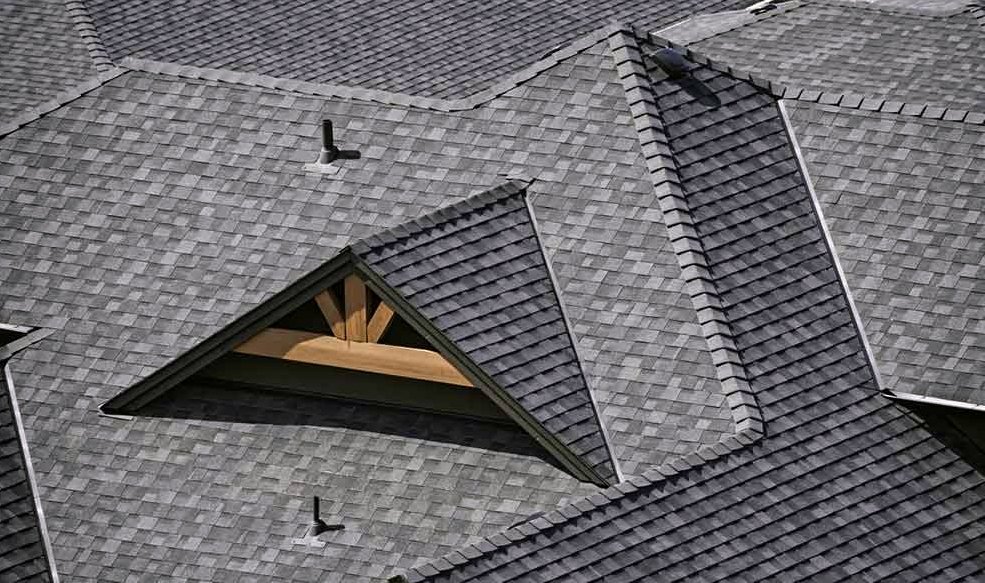With luck, you’ll only need a new roof system on your Madison WI area home once in a lifetime. When the time comes, knowing what a complete system is helps select the right roofing contractor for the job. There’s more to a roof than meets the eye. There’s more to know than what color and shape shingles you want. And, the more you know the better choices you make. Knowledge is power and you don’t want to be taken advantage of, do you?

Steep-slope roofs – a roof with a 25% slope or more like most found in southern Wisconsin – include 6 components:
- Roof covering – the basic shingles, tiles or metal that protect sublayers from the weather.
- Sheathing – boards or sheet material fasten to the roof rafters to cover the building.
- Rafters and Trusses – the basic skeleton built to hold and support sheathing.
- Flashing – sheet metal or other materials installed to various roof joints, peaks and valleys to prevent water from getting under the roof covering.
- Drainage – based upon design features like shape, slope and layout to help the roof shed water efficiently summer and winter.
- Ventilation – ventilation openings strategically places to allow the space beneath the roof to “breathe.”
A Roof System Starts With Shingles
Cost and durability head the list of determining factors when it comes to making a decision on a roof replacement job. With the help of a trusted professional roofing contractor you can weigh the importance of each component. You want style and good looks, but you want performance and reliability, too. Start with the basics as seen from the outside – roof coverings:
- Asphalt shingles – traditional asphalt shingles and newer high-tech versions are the mainstay of the roofing business. They come in a wide range of sizes, shapes and colors. Modern shingle feature organic or fiberglass reinforcing materials. Some include special chemical treatments to ward off mold, mildew and algae growth.
- Organic shingles – include a cellulose-fiber base (wood, etc.) saturated with asphalt and coated with colored mineral granules. Shingles constructed like this have been around for decades.
- Fiberglass shingles – include top and bottom layers of asphalt with a fiberglass mat sandwiched in between. Also covered with mineral granules.
Asphalt shingles are fire resistant and classified as Class A, Class B or Class C – “A” is the most fire-resistant, etc. Most fiberglass shingles are Class A and organic shingles are less fire resistant.

The reinforcing products have little impact on looks. Both can be laminated to provide textures. The composition of the shingles does make a difference in the long run. When choosing shingles for your roof replacement, the National Roofing Contractors Association (NRCA) recommends always looking for products that comply with the American Society of Testing & Materials (ASTM) standards. Ask your contractor if the product meets the standards. It’s important.
Less Common Roof Covering Options
While asphalt shingles dominate the roofing industry, there are other options available for specialty applications. You may spot a few in the Madison area, consider:
- Wood shingles and shakes – usually made from cedar, redwood or pine, they provide a natural, old-world appearance. The main difference between them is wood shingles are machine sawn and shakes are handmade and rough-looking. Fire resistance is low and maintenance is high.
- Tile – tiles on the roof, whether clay or concrete are durable and also represent a unique architectural style. If you’re going for a Spanish, French, English county side or southwestern look, they fit right in. They are very heavy so if you’re thinking of replacing a traditional roof with tile, you may have to upgrade the structure to hold the added weight.
- Synthetics – man-made materials are available to mimic all the traditional roof coverings from slate to wood, tile and shakes.
If you’re considering one of the unique shingle applications it’s a good idea to see full-size samples before making a commitment. Once the roof system is in place, you cannot take it back and change your mind. You’re looking at a major, long-term commitment, you want to do it right, don’t you?
Threats To Every Roof System, New And Old
Whether your roof is a week old or has been in place for decades, there are “enemies” lurking. A roofing system’s performance and longevity is affected by a lot of things, including:
- The sun – heat and harmful UV rays cause roofing materials to deteriorate over the years. Shaded roofs and sides facing east and north tend to last longer.
- Rain – pounding rain in a Wisconsin storm gets beneath shingles and can work its way into decking and sheathing. Excess moisture leads to rot, mold and mildew beneath the surface.
- Wind – high winds shift shingles at their edge and force water and debris underneath. We all know that storm winds can “shift” shingles completely off the roof.
- Snow and ice – The melt/freeze/melt cycle we’re all familiar with causes ice dams that block drainage. These blocks of ice put pressure on shingles and pushes water under them. Allowed to build long enough ice dams lead to not only roof damage but problems inside the house, too.
- Plant growth – moss and algae are common problems on a roof in the shade. Both holds enough moisture to cause rot to wood beneath – moss roots penetrate cracks between shingles. Algae stains as well.
- Nearby trees – leaves and branches touching the roof scape and gouge shingles. They can create opening for water. Branches blown onto the roof in a storm might puncture shingles and layers below if they’re big and heavy enough. Leaves clog gutters and downspouts and can cause the same damage as an ice dam.
Do Your Own Roof Inspection
After the rigors of another cold and snow-packed Madison winter, do a walk-around inspection of your roof. Look specifically for:
- Torn or missing shingles – the most obvious sign of a roofing problem is an area devoid of shingles. If you see one or more missing it’s time to act. One missing shingle leads to several more disappearing. You might be able to have the area repaired. Call in a professional roofing contractor and make sure.
- Changes in flashing – the metal seams around chimneys, vents and roof pitch changes also wear over time. They are subject to the same stress from snow and ice as gutter areas, too. Tight flashing keeps moisture out. Warped or bent flashing is an opening for a leak somewhere below.
- Ice damage – if you dealt with an ice dam (or worse, had one and did nothing about it) take time to check shingles and gutters in the area to be sure they’re securely fastened and in good condition. If not today’s damage could haunt you next winter.
Understand Roof System ‘Language’
When the time come to meet with a roofing contractor you may think they’re speaking a foreign language. There are a lot of terms roofers use that are very specific to products and the process. Among terms you’ll find useful are:
- Decking/Sheathing – usually plywood or oriented strand board (OSB) providing a smooth surface to attach components of the roofing system.
- Felt/Underlayment – sheets of asphalt-saturated materials put down to protect the decking. Often called “tar paper.”
- Vapor barrier – a material installed beneath shingles to restrict the passage of moisture through the roof systems. Also installed inside the attic beneath the roof.
- Flashing – metal installed around roof valleys, joints and seams near chimneys, vent pipes, etc. to prevent water from seeping in.
- Louvers – slatted vent cover installed in a gable or soffit (beneath the eaves) to help equalize air temperature and moisture levels in the attic.
It’s true the more you know ahead of time, the better decisions you can make. However, learning on your own is difficult. That’s why contacting a professional roofing contractor you can trust is essential. When it comes to one of the biggest decisions you’ll make in the life of your home, you don’t want to cut corners or make mistakes, right?
You may be stunned to learn that as many as 80% of all roofing companies vying for your business today will be in business for fewer than 5 years. Sims Exteriors & Remodeling has beaten those odds, serving Madison area homeowners for decades. We’re here to serve Madison today, tomorrow and for years to come. We work with the best roofing system suppliers in the industry and their extensive warranties are second-to-none. In addition, we provide our own workmanship guarantee. Sims delivers industry-leading products and peace of mind.
If you’ve seen signs that your roof needs help or just want a timely inspection, contact Sims Exteriors & Remodeling at 608-825-4500 or via email. When it’s time for a new roof system or repair, we’re the professionals Madison WI homeowners count on.

